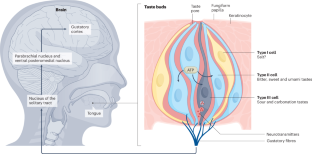作为肠腔内容物传感器的苦味感受器
IF 45.9
1区 医学
Q1 GASTROENTEROLOGY & HEPATOLOGY
引用次数: 0
摘要
味觉在选择食物时非常重要,由一组不同的受体--味觉 G 蛋白偶联受体(GPCRs)--协调。味觉 1 受体(小鼠的 Tas1rs 和人类的 TAS1Rs,也称为 T1Rs)可检测甜味和鲜味,味觉 2 受体(小鼠的 Tas2rs 和人类的 TAS2Rs,也称为 T2Rs)可检测苦味。这些受体在口外部位也有表达,包括胃肠粘膜。作为预防或治疗代谢紊乱的潜在靶点,Tas2rs/TAS2Rs 引起了人们的兴趣。这些苦味受体在功能不同类型的胃肠道粘膜细胞(包括肠内分泌细胞)中表达,这些细胞在受到刺激时会增加细胞内 Ca2+ 并释放信号分子,从而调节对营养物质的消化和吸收、有害物质的中和与排出以及新陈代谢调节至关重要的肠道化学感受过程。Tas2rs/TAS2Rs在肠道粘膜中的表达受高脂肪饮食的影响而上调,肠道内的苦味 "味道剂 "通过局部和肠道-大脑轴信号影响胃肠功能和摄食行为。Tas2rs/TAS2Rs还存在于释放抗菌肽和糖蛋白的Paneth细胞和鹅口疮细胞以及触发针对寄生虫的2型免疫反应的簇细胞中,从而为抵御病原体提供了一道直接防线。本综述将重点探讨肠道 Tas2r/TAS2R 在肠内分泌细胞中的分布、信号传导和调节,支持它们作为肠腔内容物化学传感器的作用,这些化学传感器具有调节机体平衡和免疫反应的独特功能。本文章由计算机程序翻译,如有差异,请以英文原文为准。


Bitter taste receptors as sensors of gut luminal contents
Taste is important in the selection of food and is orchestrated by a group of distinct receptors, the taste G protein-coupled receptors (GPCRs). Taste 1 receptors (Tas1rs in mice and TAS1Rs in humans; also known as T1Rs) detect sweet and umami tastes, and taste 2 receptors (Tas2rs in mice and TAS2Rs in humans; also known as T2Rs) detect bitterness. These receptors are also expressed in extraoral sites, including the gastrointestinal mucosa. Tas2rs/TAS2Rs have gained interest as potential targets to prevent or treat metabolic disorders. These bitter taste receptors are expressed in functionally distinct types of gastrointestinal mucosal cells, including enteroendocrine cells, which, upon stimulation, increase intracellular Ca2+ and release signalling molecules that regulate gut chemosensory processes critical for digestion and absorption of nutrients, for neutralization and expulsion of harmful substances, and for metabolic regulation. Expression of Tas2rs/TAS2Rs in gut mucosa is upregulated by high-fat diets, and intraluminal bitter ‘tastants’ affect gastrointestinal functions and ingestive behaviour through local and gut–brain axis signalling. Tas2rs/TAS2Rs are also found in Paneth and goblet cells, which release antimicrobial peptides and glycoproteins, and in tuft cells, which trigger type 2 immune response against parasites, thus providing a direct line of defence against pathogens. This Review will focus on gut Tas2r/TAS2R distribution, signalling and regulation in enteroendocrine cells, supporting their role as chemosensors of luminal content that serve distinct functions as regulators of body homeostasis and immune response. Type 2 taste receptors (Tas2rs in mice and TAS2Rs in humans) detect bitter stimuli and are present in both the oral cavity and extraoral sites. In this Review, the authors discuss Tas2rs/TAS2Rs in the gastrointestinal enteroendocrine system and how they could be potential targets to prevent or treat metabolic disorders.
求助全文
通过发布文献求助,成功后即可免费获取论文全文。
去求助
来源期刊
CiteScore
52.30
自引率
0.60%
发文量
147
审稿时长
6-12 weeks
期刊介绍:
Nature Reviews Gastroenterology & Hepatology aims to serve as the leading resource for Reviews and commentaries within the scientific and medical communities it caters to. The journal strives to maintain authority, accessibility, and clarity in its published articles, which are complemented by easily understandable figures, tables, and other display items. Dedicated to providing exceptional service to authors, referees, and readers, the editorial team works diligently to maximize the usefulness and impact of each publication.
The journal encompasses a wide range of content types, including Research Highlights, News & Views, Comments, Reviews, Perspectives, and Consensus Statements, all pertinent to gastroenterologists and hepatologists. With its broad scope, Nature Reviews Gastroenterology & Hepatology ensures that its articles reach a diverse audience, aiming for the widest possible dissemination of valuable information.
Nature Reviews Gastroenterology & Hepatology is part of the Nature Reviews portfolio of journals.

 求助内容:
求助内容: 应助结果提醒方式:
应助结果提醒方式:


